The AMD FX (Bulldozer) Scheduling Hotfixes Tested
by Anand Lal Shimpi on January 27, 2012 12:47 PM ESTMixed Workloads: Mild Gains
The one thing all of the following benchmarks have in common is they feature more varied CPU utilization. With periods of heavy single and all core utilization, we also see times when these benchmarks use more than one core but fewer than all.
SYSMark has always been a fairly lightly threaded test. While there are definite gains seen when going from 2 to 4 cores, this is hardly a heavily threaded test. The performance impact of the hotfixes is negligible in the overall performance result or across the individual benchmark suites however:
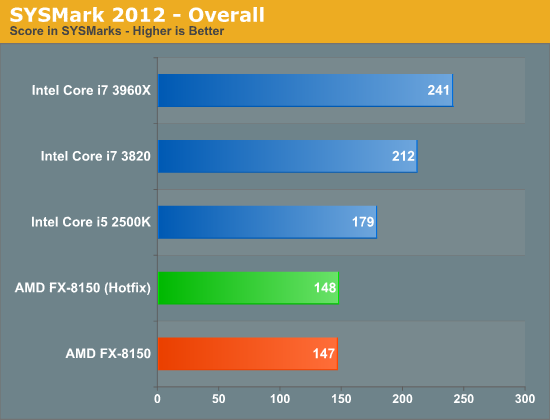
Our Visual Studio 2008 compile test is heavily threaded for the most part, however the beginning of the build process uses a fraction of the total available cores. The hotfixes show a reasonable impact on performance here (~5%):
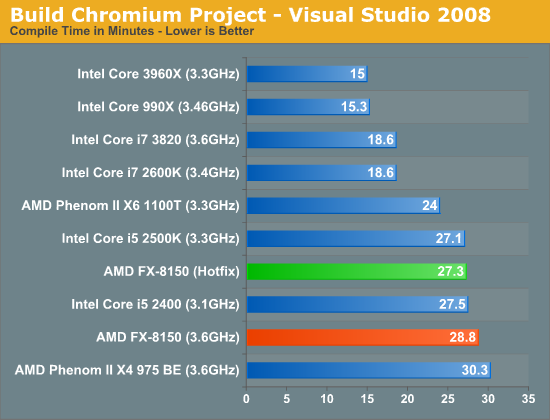
The first pass of our x264 transcode benchmark doesn't use all available cores but it is more than just single threaded:

Performance goes up but only by ~2% here. As expected, the second pass which consumes all cores in the system remains unchanged:
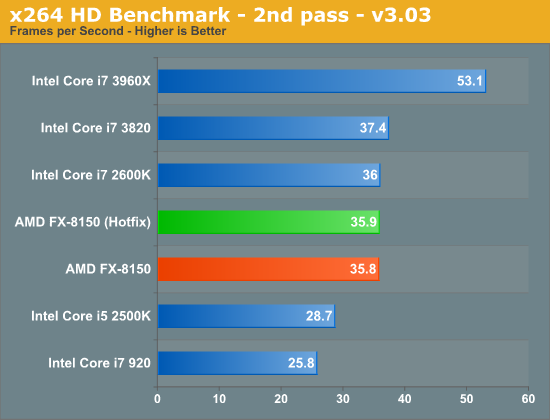
Games are another place we can look for performance improvements as it's rare to see consistent, many-core utilization while playing a modern title on a high-end CPU. Metro 2033 is fairly GPU bound and thus we don't see much of an improvement, although for whatever reason the 51.5 fps ceiling at 19x12 is broken by the hotfixes.

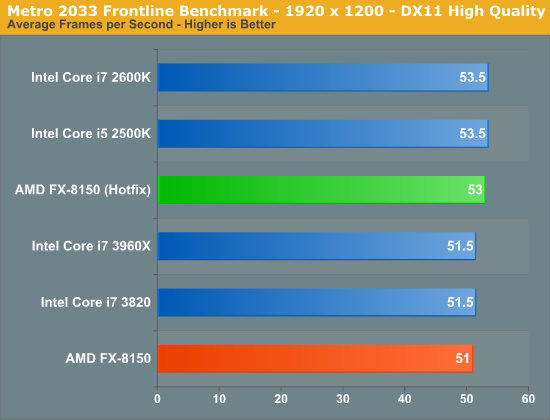
DiRT 3 shows a 5% performance gain from the hotfixes. The improvement isn't enough to really change the standings here, but it's an example of a larger performance gain.
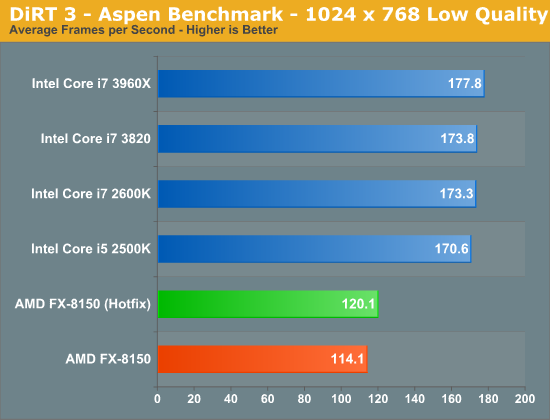
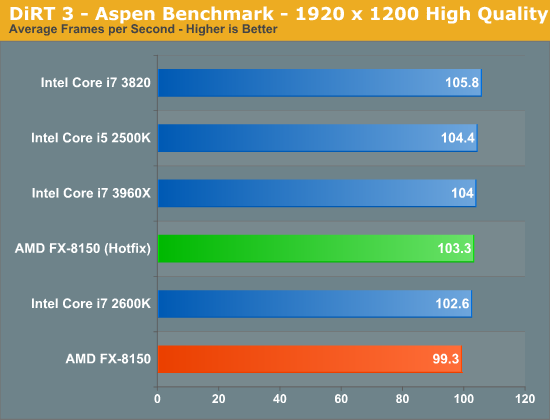
Crysis Warhead mirrors the roughly 5% gain we saw in DiRT 3:
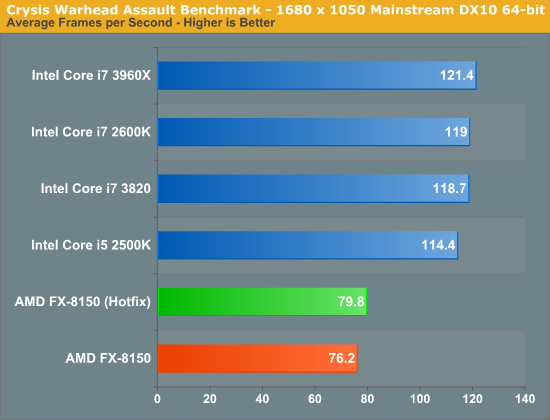
Civilization V's CPU bound no render results show no gains, which is to be expected. But looking at the average frame rate during the simulation we see a 4.9% increase in performance.
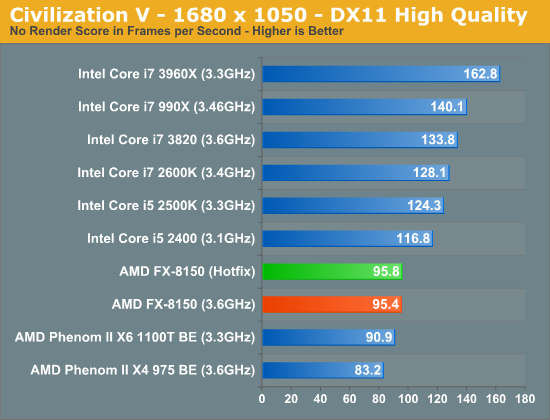
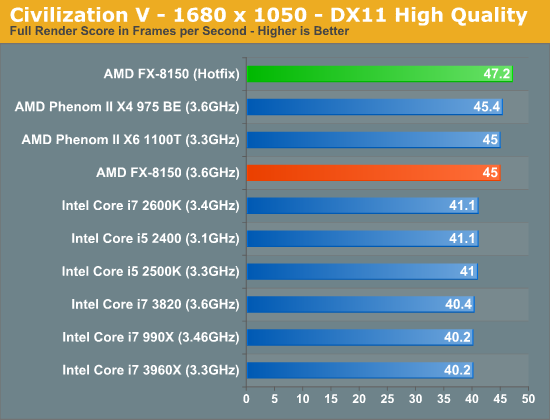










79 Comments
View All Comments
Conficio - Saturday, January 28, 2012 - link
This kind of problem, more intelligent schedulers for a new architecture cries for open source to be the experiment and proofing ground.So I'd like to know what the scheduling behavior of Linux, BSD (and in extension Mac OS X, once Apple does use the architecture) is? Has AMD any experience? Do they work with any Universities to find optimal algorithms for this new architecture?
If such new architectures where the "core" concept blurs will be more common in the future, there is sure some research that can shed some light on this topic. Does any body know?
just4U - Monday, January 30, 2012 - link
I had to figure out what to do for our secondary system. Eventually I decided on the FX6100 which I picked up for $145... so a little bit more then a midrange I3. The board I got was a Asus M5A EVO for $110. That system is pretty fast... and I think overall a little better then what I'd have gotten out of an I3. I am on a i5 2500K everyday.. and before that a i7 920 setup..These new FX proccessors are not what some reviewers make them out to be. Their actually pretty good for their price range. Are they going to win any awards? Likely not.. but for most of us your not going to be pulling your teeth and whining about it being slow because their not.
Mugur - Monday, January 30, 2012 - link
I wonder if the fact that the memory controller is running at 2-2.2 Ghz instead of the full cpu speed on Intel (the uncore part) and the cache latency is higher on AMD maked also FX cpus not competitive in single threaded tasks?Regarding the memory speed, I remember that high speed DDR 3 is required for the AMD APU line, not the FX line...
I recently changed my gaming machine from a Phenom II X2 BE 3.3 Ghz (ran at 3.8 Ghz) to a Core i3 2120 and although some tasks in Windows seems a little slower (like browsing with a lot of pages opened - I have no ideea why - maybe the amount of cache PII had compared with the i3?), the gaming (Battlefield 3) improved a lot.
I wanted to go FX route, but simply looking on some gaming benchmarks made me go Intel (and the fact that I found a cheap Z68 Gigabyte board, people are not taking into account that sometimes a good Z68 board is twice the price of a good AMD board). The other components were a 60 GB SSD / 500 GB HDD, 8 GB DDR1600 and a Radeon 6870.
What I wanted to point out is that AMD does not compete through price properly with the FX line. A Core i3 2120 is about the same price like an FX 4100 and a Core i5 2500k has a lower price than an FX 8150. Only a high end Z68 board is (much) more expensive than an 8xx/9xx AMD AM3+ board...
Scali - Monday, January 30, 2012 - link
We've seen linux kernel patches for Bulldozer that have about as much effect:http://openbenchmarking.org/result/1110200-AR-BULL...
Let's just blame AMD, shall we?
richaron - Monday, January 30, 2012 - link
I've seen linux benchmarks, before any patch, which show the 8150 perform much better compared to the 2500k. Check the Phorinox benchmarks (unfortunately there's no 2600k in them).Let's just blame Microsoft, shall we?
Scali - Tuesday, January 31, 2012 - link
Well no.The point here is that kernel patches don't really have much of an effect on Bulldozer performance. There's no 'magic bullet'.
If the 8150 performs better compared to the 2500k in linux, that is a different story.
How does performance in linux compare to Windows?
It could also be that linux is just slower on the 2500k than Windows is (which I'm quite sure to be the case).
So no, I'll just blame AMD. The Bulldozer module architecture just doesn't work.
superccs - Monday, January 30, 2012 - link
How come this was not developed in association with windows BEFORE release....???? That's like releasing a new GPU without having a firmware that runs the new feature set.I sure hope the recent house cleaning at AMD got rid of some of these upper level jack@sses responsible.
wingless - Monday, January 30, 2012 - link
The 4100 and 6100 look like they could gain a bit from this patch as well. Will there be a test with them included?just4U - Monday, January 30, 2012 - link
I don't see either of them on bench results. Did Anand even review them? I don't think they did.Trailmixxx - Monday, January 30, 2012 - link
Has droppend from over by a factor of 5 on my system after applying the hotfixes. Can someone else confirm this? And possibly on an Intel system as well?